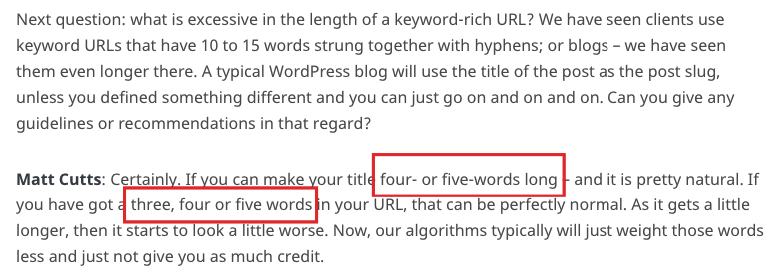Source: Neil Patel URLs. They’re one of the most basic elements of SEO. Yet they’re vitally important. In fact, Backlinko reports that URLs are a s

URLs. They’re one of the most basic elements of SEO. Yet they’re vitally important.
In fact, Backlinko reports that URLs are a significant ranking factor.
More specifically:
- URL length is listed as #46 in Google’s top 200 ranking factors
- URL path is listed as #47
- Keyword in the URL is #51
- URL string is #52
So when you put it all together, URL optimization is kind of a big deal.
And it seems simple enough.
Enter a few words into the URL slug, throw in a keyword or two and you’re good. Right?
If only it were that easy.
In reality, there’s an entire science behind proper URL optimization.
But after tons of research and a lot of trial and error on my end, I’ve come up with what I think is a rock solid formula.
It covers all of the bases and aims to satisfy both search engine bots and of course human users.
In this post, I’m going to explain the science behind creating URLs for maximum SEO as well as the logic behind each tactic.
So let’s get to it.
Choose a top level domain
Let’s start from the beginning.
There’s an infographic from Search Engine Land that covers the ins and outs of friendly URL structure.
One thing they point out is that using a top level domain (TLD) is usually your best bet.
This simply means that it’s ideal to use a “.com” domain rather than “.biz,” “.pro,” “.tel,” etc.
Now I’m not saying that you’re doomed if you use anything other than “.com” for your domain.
In fact, TLD doesn’t directly impact rankings.
But what it does tend to do is increase trust for human users.

And this is huge.
When people trust your domain, it’s going to trickle down and have a positive impact on your overall SEO.
I realize that making this point doesn’t do you a lot of good if you already have a domain other than “.com.”
I also realize that it’s simply not realistic to be able to land your brand name with a “.com” domain (there were over 124 million “.com” domains of 2016), but it’s something to keep in mind if you’re choosing a domain in the future.
This post offers some insight on what you can do if the domain name you want is already taken.
HTTPS is ideal
Online security is a huge issue these days.
With cyber crime and identity theft on the rise, Internet users want to know that they’re using a secure connection.
Just look at how the monetary damage reported by cyber crime has increased from 2001 to 2015.

It’s dramatic.
As a result, I really recommend using HTTPS rather than HTTP.
If you’re unfamiliar with the difference, HTTPS stands for “HyperText Transfer Protocol Secure,” which is the secure version of HTTP.
This simply means that information on a website is encrypted, which heightens security significantly.
Here’s an illustration of the difference between HTTP and HTTPS.

Not only does this keep your visitors at ease, it has actually become a ranking signal.
According to Searchmetrics, “HTTPS is becoming more relevant and even a ranking signal for Google. Encryption is primarily important for sites with purchasing processes or sensitive client information to increase trust and conversion rates.”
And in my opinion, this is likely to become an even bigger ranking signal in the future.

If your site hasn’t yet received an SSL certificate, I suggest taking care of this ASAP.
This is especially true if you actually process customer orders and capture sensitive financial information online.
You can learn about the details of this process here.
There are several companies you can choose from to buy an SSL certificate.
One of the top providers is Namecheap.
First, you choose a plan to buy.

Then choose the number of years you want your SSL certificate to last.

Then confirm your order.

Once it’s activated, you’ll need to install your SSL certificate and update your site to use HTTPS.
This is fairly technical, but you can find pretty much everything you need from this resource.
It will walk you through step by step.
Length

Now that we’ve gotten the more technical aspects of URL optimization out of the way, let’s get down to the nuts and bolts.
The element I’d like to address first is length, and it’s a biggie.
But when you really break it all down, deciding on the length of a URL is quite simple.
The shorter the better.
According to Backlinko, “Shorter URLs tend to rank better than long URLs.”
To prove this, they performed some extensive testing on one million Google search results.
Here’s a graph that shows how Google rankings decline as URL length gets longer.

It’s pretty cut and dry.
Notice how the number one position has URLs with roughly 50 characters.
But once you move down to the number 10 spot, the average URL has 62 characters.
So somewhere around 50 – 60 characters is a pretty good number to shoot for.
If you go way beyond (say 80+ characters), this is likely to have a negative impact on your ranking.
How many words should you use?
I personally try to shoot for around three to five words per URL because it’s simple and gives users a pretty clear idea of what a particular piece of content is all about.
Here are a couple of examples from NeilPatel.com


See what I mean?
I keep the number of words in these URLs to a minimum, but you can still get a sense of what you can expect to find by clicking on those links.
According to an interview with Matt Cutts, this is a pretty good formula to stick with.
Here’s a snippet from the interview.

The bottom line is that you want to condense the essence of your content into roughly three to five words and try to use a max of 60 characters.
If you consistently implement this formula, you should be good to go.
Readability

Like I said earlier, there’s a…

COMMENTS